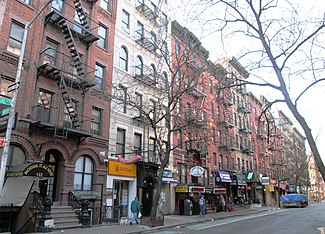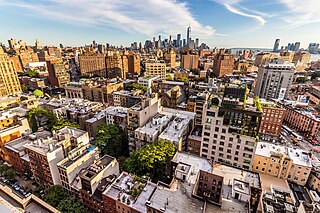
Greenwich Village, or simply the Village, is a neighborhood on the west side of Lower Manhattan in New York City, bounded by 14th Street to the north, Broadway to the east, Houston Street to the south, and the Hudson River to the west. Greenwich Village also contains several subsections, including the West Village west of Seventh Avenue and the Meatpacking District in the northwest corner of Greenwich Village.

8th Street is a street in the New York City borough of Manhattan that runs from Sixth Avenue to Third Avenue, and also from Avenue B to Avenue D; its addresses switch from West to East as it crosses Fifth Avenue. Between Third Avenue and Avenue A, it is named St. Mark's Place, after the nearby St. Mark's Church in-the-Bowery on 10th Street at Second Avenue.

Cafe Wha? is a music club at the corner of MacDougal Street and Minetta Lane in the Greenwich Village neighborhood of Manhattan, New York City. The club is important in the history of rock and folk music, having presented numerous musicians and comedians early on in their careers, including Bob Dylan, Jimi Hendrix, Bruce Springsteen, the Velvet Underground, Cat Mother & the All Night Newsboys, Kool & the Gang, Peter, Paul and Mary, Woody Allen, Lenny Bruce, Joan Rivers, Bill Cosby, Richard Pryor, and others
Theodore Stewart "Skip" Weshner was an American radio disc jockey on stations in New York and Los Angeles from the mid-1950s until the mid-1980s. In particular, he hosted a popular show on KRHM-FM in Los Angeles.

The Gaslight Cafe was a coffeehouse in the Greenwich Village neighborhood of Manhattan, New York. Also known as The Village Gaslight, it opened in 1958 and became notable as a venue for folk music and other musical acts. It closed in 1971.

4th Street is a street in Lower Manhattan, New York City. It starts at Avenue D as East 4th Street and continues to Broadway, where it becomes West 4th Street. It continues west until the Avenue of the Americas, where West 4th Street turns north and confusingly intersects with West 10th, 11th, 12th, and 13th Streets in Greenwich Village. Most of the street has the same 40-foot (12 m) width between curbstones as others in the prevailing street grid, striped as two curbside lanes and one traffic lane, with one-way traffic eastbound. The portion from Seventh to Eighth Avenues is westbound and is approximately 35 feet (11 m) wide, a legacy of the original Greenwich Village street grid. The section of four short blocks from MacDougal Street to University Place which forms the southern border of Washington Square Park is called Washington Square South.

Waverly Place is a narrow street in the Greenwich Village section of the New York City borough of Manhattan, that runs from Bank Street to Broadway. Waverly changes direction roughly at its midpoint at Christopher Street, turning about 120 degrees from a north/south street to a northwest/southeast street. At Christopher Street, the traffic direction changes as well, from southbound to westbound. At the intersection where this transition occurs, Waverly branches into a Y, creating an intersection of Waverly Place with itself.

The Whitney Museum of American Art's original building is a collection of three 1838 rowhouses at 8–12 West 8th Street, between Fifth Avenue and MacDougal Street, in the Greenwich Village neighborhood of Manhattan in New York City. In 1907, Gertrude Vanderbilt Whitney established the Whitney Studio Gallery at 8 West 8th Street adjacent to her own MacDougal Alley studio. This, and the later Whitney Studio Club at 147 West 4th Street, were intended to provide young artists with places to meet and exhibit their works.

Bank Street is a primarily residential street in the West Village part of Greenwich Village in the borough of Manhattan in New York City. It runs for a total length of about 725 metres (2,379 ft) from West Street, crossing Washington Street and Greenwich Street, to Hudson Street and Bleecker Street where it is interrupted by the Bleecker Playground, north of which is Abingdon Square; it then continues to Greenwich Avenue, crossing West 4th Street and Waverly Place. Vehicular traffic runs west-east along this one-way street. As with several other east-west streets in the Far West Village, the three blocks west of Hudson Street are paved with setts.

The South Village is a largely residential area that is part of the larger Greenwich Village in Lower Manhattan, New York City, directly below Washington Square Park. Known for its immigrant heritage and bohemian history, the architecture of the South Village is primarily tenement-style apartment buildings, indicative of the area's history as an enclave for Italian-American immigrants and working-class residents of New York.

The Charlton–King–Vandam Historic District is a small historic district in Lower Manhattan, New York City. Designated by the New York City Landmarks Preservation Commission (NYCLPC) in 1966, the district contains "the city's largest concentration of row houses in the Federal style, as well as a significant concentration of Greek Revival houses." It is sometimes included as part of the South Village or Hudson Square, though it is historically distinct from both neighborhoods.
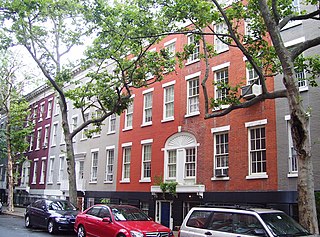
The MacDougal–Sullivan Gardens Historic District is a small historic district consisting of 22 houses located at 74–96 MacDougal Street and 170–188 Sullivan Street between Houston and Bleecker Streets in the South Village area of the Greenwich Village neighborhood of Manhattan, New York City.
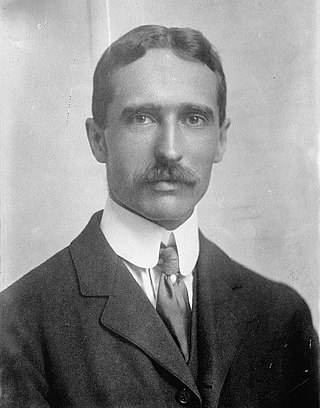
William Sloane Coffin Sr. was an American businessman. He was a director, and later vice-president of W. & J. Sloane Company, his family's business, which was founded by his grandfather, William Sloane, from Kilmarnock, Scotland. He became president of the board of trustees of the Metropolitan Museum of Art, and founded the Hearth and Home Corporation to provide housing in downtown Manhattan, New York City.

Avignone Chemists was an American full service pharmacy located in New York's Greenwich Village. Avignone Chemists was founded in 1832 which made it the oldest apothecary in the United States. Avignone marketed itself as the Independent Anti-Chain Pharmacy. It closed in 2015.

Sullivan Street is a street in Lower Manhattan, which previously ran north from Duarte Square at Canal Street, but since around 2012 begins at Broome Street, to Washington Square South, through the neighborhoods of Hudson Square, SoHo, the South Village and Greenwich Village. It runs parallel to and between Macdougal Street and Thompson Street. Part of the street is in the MacDougal–Sullivan Gardens Historic District. The street was named for Revolutionary War Major General John Sullivan in 1799; before then, it was known as Locust Street.

The San Remo Cafe was a bar at 93 MacDougal Street at the corner of Bleecker Street in the New York City neighborhood of Greenwich Village. It was a hangout for Bohemians and writers such as James Agee, W. H. Auden, Tennessee Williams, James Baldwin, William S. Burroughs, Gregory Corso, Miles Davis, Allen Ginsberg, Billy Name, Frank O'Hara, Jack Kerouac, Jackson Pollock, William Styron, Dylan Thomas, Gore Vidal, Judith Malina, and many others. It opened in 1925 and closed in 1967.
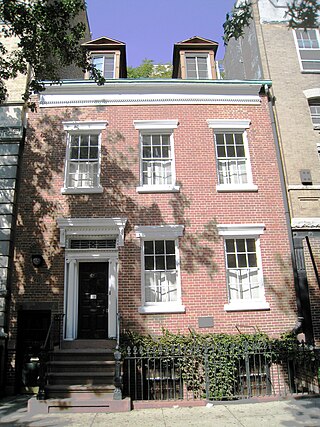
Charles Street is a street in the West Village neighborhood of Manhattan in New York City. It runs east to west from Greenwich Avenue to West Street. The street was named after Charles Christopher Amos, who owned the parcel the street passed through. Amos is also the namesake of Christopher Street, two blocks to the south, and the former Amos Street, which is now West 10th Street. Charles Lane is a one-block alley located between Charles and Perry Streets and Washington and West Streets. From 1866 to 1936, the section of Charles Street between Bleecker Street and West 4th Street was called Van Ness Place after a farm, owned by the Van Ness family, which had occupied the square bounded by Bleecker, West 4th, Charles and Perry Streets until 1865.
Eva Kotchever, known also as Eve Adams or Eve Addams, born as Chawa Złoczower, was a Polish-Jewish émigré librarian and writer, who is the author of Lesbian Love and from 1925 to 1926 ran a popular, openly lesbian literary salon in Greenwich Village, Lower Manhattan, called Eve's Hangout. It closed after Eva was convicted and jailed for obscenity and disorderly conduct, which resulted in her deportation to Poland in 1927. She was later arrested in France in 1943 and deported to the Auschwitz concentration camp December 17, where she died two days later, December 19.

Eve's Hangout was a New York City lesbian nightclub established by Polish-Jewish feminist Eva Kotchever in Greenwich Village, Lower Manhattan, in 1925. The establishment was also known as "Eve Adams' Tearoom", a pun on the names Eve and Adam.
Kettle of Fish is a historic bar in Greenwich Village, Manhattan, New York City. The bar was opened in 1950 on MacDougal Street, but in 1987 it relocated to the former site of Gerde's Folk City, before moving again in 1999 to its current location on Christopher Street.
